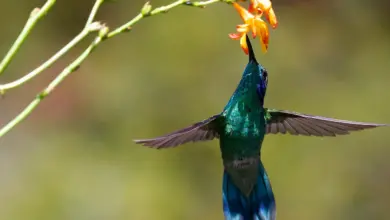Violaceous Trogons (Trogon violaceus)
The Violaceous Trogons (Trogon violaceus) – also known as the Guianan Trogons – occur naturally in southern Mexico, Central America, and northern South America.
Within their range, these solitary trogons are generally resident (non-migratory) within their range. Their primary habitats are tropical forest areas ranging from sea level up to 3,300 feet (~1000 meters). They are most commonly found in evergreen and savanna forests, clearings, and plantations.
The Violaceous Trogons were previously lumped together with the South American Amazonian Trogons (Trogon ramonianus) and Gartered Trogons (Trogon caligatus). However, most authorities now treat them as separate species based on genetic and vocalization data. Different opinions exist and the taxonomy may change again in the future. These trogons are closely related to the White-tailed / Green-tailed Trogon (Trogon viridis) and Blue-crowned Trogons (Trogon curucui).
These birds demonstrate a strange behavior that is commonly referred to as “anting.” This involves carving into ant nests and allowing ants to release formic acid on their bodies. The reason for this strange behavior may be to get rid of feather parasites, such as feather mites, or to control fungi or bacteria; however, some believe that they gain pleasure from this activity.
Subspecies and Ranges:
Guianan Trogon or Violaceous Trogon or Lesser Yellow-bellied Trogon (Trogon violaceus)
ID: Vocalizations described as a soft cow cow, cow.
- Guianan Trogon (Trogon violaceus violaceus – Gmelin, 1788)
- Range: Eastern Venezuela, the Guianas, adjacent northern Brazil; and the island of Trinidad.
Amazonian Trogon (Trogon ramonianus) – Now separated
- Amazonian Trogon (Trogon ramonianus ramonianus – Nominate form – Deville & Des Murs, 1849)
- Range: southwestern Amazonia
- Amazonian Trogon (ssp. crissalis) (Trogon ramonianus crissalis – Cabanis & Heine, 1863)
- Range: Northern Amazonia (northeastern Brazil) and southern Venezuela south to east of the Tapajós River (in southeastern Amazonian Brazil).
Gartered Trogon (Trogon caligatus)
ID: Vocalizations described as a slurred whistled cuh-cuh-cuh
Description
Size
- Average Length (including tail): 9.1 inches or 23 cm
- Average Weight: 2 oz or 56 g
Plumage Details / Adults
Male: Deep, shiny, violet-blue to blackish head and neck; green back with a blue hue towards the rump; blackish wings with some white, wavy lines; royal blue throat; orange-yellow lower chest, abdomen and vent. The white-tipped undertail feathers have even black and white horizontal stripes. There may be a thin white line separating the chest from the yellow abdomen.
Female: Head, back, and chest are dark grey. The abdomen is a dull yellow belly. Thin black and white wing bars. White eyerings are broken above and below the eye.
Other Physical Details
- Eyerings: Yellow in the males and white/incomplete in the females
- Bill: Broad, pale grey-green in color
Similar Species
- White-tailed Trogons have blue eye rings, rather than yellow; they are also larger in size and have whiter tails. Male lacks barring in the undertail.
- The shade of the blue of the head in the male differs between the Violaceous Trogon and the Gartered Trogon, but they can most easily be differentiated by their different vocalizations: The Gartered has a slurred whistled cuh-cuh-cuh, and Violaceous has a soft cow cow, cow.
Diet / Feeding
Their diet consists of small fruit and, to a lesser extent, insects and their larvae.
Breeding / Nesting
Violaceous Trogons are monogamous. These cavity nesters raise their young in large, active wasp, ant, or termite mounts or in the holes of rotten trees. It is speculated that nesting in arboreal nests of termites and ants offers them some protection against predators.
The average nest contains 2 to 3 white eggs.
Calls / Vocalizations / Sounds and Videos
https://www.xeno-canto.org/133151/embed?simple=1
Alternate (Global) Names
Czech: Trogon fialový, trogon pralesní …Chinese: ?????? … Danish: Blågul Trogon … Dutch: Violette Trogon … German: Veilchentrogon … Estonian: herilase-järanokk … Finnish: Pikkutrogoni … French: Trogon violacé, Trogon violacé ou T. pattu … Italian: Trogone violaceo … Japanese: himekinubanedori … Norwegian: Gulbrilletrogon … Polish: trogon fioletowoglowy, trogon fioletowog?owy … Portuguese: surucuá-miudinho, surucuá-pequeno, Surucuá-pequfno-de-barriga, surucuá-violeta … Russian: ?????????? ?????? … Slovak: trogón amazonský, Trogón fialkovohlavý … Spanish: Coa violacea, Surucuá Violeta Chico, Trogon Violáceo, Trogón Violáceo, Violette Trogon …Swedish: Violetthuvad trogon




